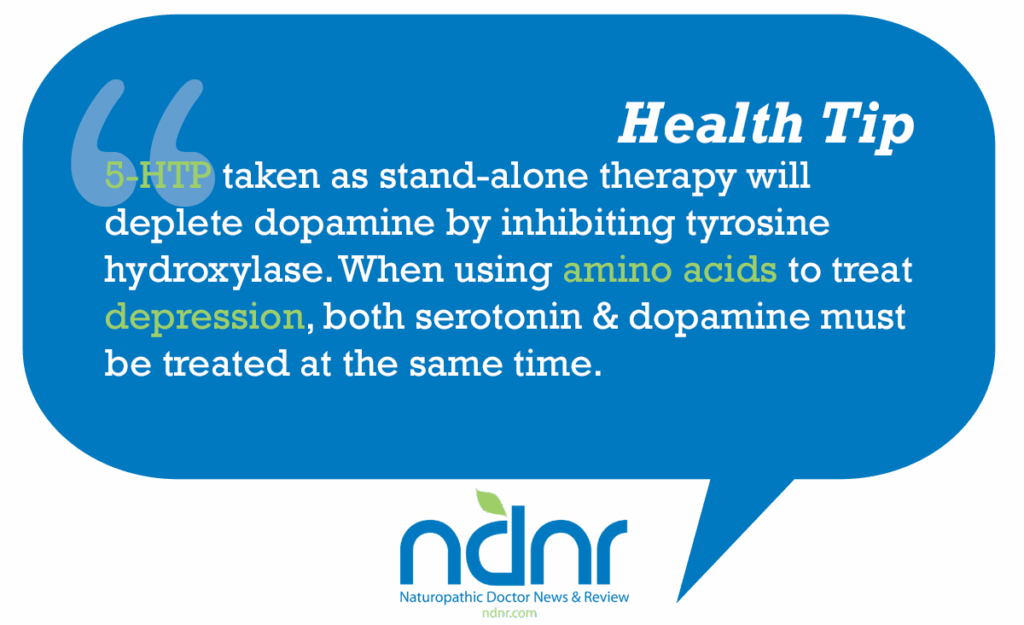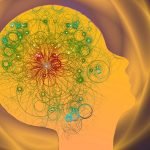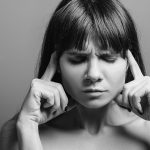Depression: Protocols for Repairing Biochemical and Neurochemical Processes
David Arneson, ND
Depression is defined in Stedman’s Medical Dictionary 25th Edition1 as a reduction of the level of functioning. It is also defined as a sinking of spirits so as to constitute a clinically discernible condition. Endogenous depression is further defined as a descriptive syndrome for a cluster of symptoms and features occurring in the absence (or what seems to be) of precipitants. However one describes it, depression will affect most everyone sometime in their lives. Stedman’s goes on to define reactive depression as a psychological state occasioned directly by an intensely sad (or challenging) external situation, relieved by the removal of the external situation. In the latter definition, we might define depression not as a disease but more as a great sense of unacceptable “dys-ease.”
It is obvious that depression can be defined as an abnormality of normal functioning of the body-mind-spirit and may be created by internal or external forces. Depression is a symptom, or set of symptoms, that allows the physician to pinpoint a cause and treat the patient effectively. There are multiple possible causes of biochemical depression, including hypothyroidism, dehydration, inadequate protein intake, inadequate vitamin and mineral intake, cardiovascular disease, poor diet in general, and inadequate digestion and absorption of food, to name a few. Furthermore, drugs such as antidepressants may exacerbate depression. Environmental toxins such as mercury poisoning can cause depression. Also causative may be life changes such as a new job, loss of a loved one, economic changes, or children leaving the home to go to school. The clinician bodes well to run standard laboratory tests such as a complete blood cell count, chemistry panel, hormone panels, and thyroid panels. A nutritional assessment is necessary. It is also well known that those who get regular exercise and drink at least 60 fl oz of water per day have fewer incidences of depression.
Why one is depressed is infinitely more important than whether he or she is depressed. Michael Davison, BSME,2 who has his own battle with depression, summarizes his journey with these conclusions: (1) Depression can be thought of as a friend; good friends do not always say what we like. (2) Good friends offer understanding and insight through mutual trust. (3) Depression is a consequence, an effect, and not a cause. (4) One does not wipe out depression and live happily; one lives effectively and fulfillingly, and depression rarely shows up.
Dr Viktor Frankl, the author of Man’s Search for Meaning3 and The Unheard Cry for Meaning,4 and others have elucidated the most common cause of depression today. Bruce Levine, PhD,5 summarizes these thoughts: (1) The rate of emotional difficulties and self-destructive behaviors has increased since the advent of the industrial revolution. (2) Our genes have not changed; society has changed. (3) It can be argued that what we call a mental illness is actually a rebellion (more often passive than active) against an increasingly dehumanizing society in which consumption, production, and technology are worshipped at the expense of life. (4) Society, as well as mental health treatment, has become radically industrialized and commercialized, resulting in a loss of historical antidotes to emotional malaise such as autonomy, meaning, and community.
The Allopathic Model of Depression
The allopathic medical model will always define depression as a disease. It will matter little why one is depressed; the solution will always be drugs. The ND will ask the patient the obvious question: why do you think you are depressed? If the physician will listen to the patient, he or she will be able to communicate to the patient the most likely path of treatment. Most patients know exactly why they are depressed, and most MDs do not have the time to listen. In fact, only about 15% of the patients we see will have what is called endogenous depression, or the kind of depression that may have a genetic determinant. Even then, many of these cases are treatable. One might not be able to change the gene, but we can give the gene a nutritional environment with which to optimize the gene’s ability to produce the neurotransmitters. Yet there are those who are severely mentally ill. One will find in clinical practice that there will be some 5% of cases for whom we do not have an answer or solution.
Patients may respond that they might be depressed because of a strong indicator of genetics having a role in depression. The answer might come in this form: “I don’t know, doc. Seems like I have been depressed my whole life.” Very few patients will say this. In my clinical experience, these will be less than 15% of the cases you treat. As already noted, patients usually know why they are depressed. This is borne out by the recent research done on the efficacy of antidepressants. Since antidepressants remain the most used therapy in treating depression, we must understand the truth about these drugs. In an analysis of 6 large studies published in JAMA, it was found that antidepressants worked only in the most severe cases of depression, namely, 13% of the people with depression, as reported by Sharon Begley6 in Newsweek Magazine.
Using multiple meta-analyses, David Healy, MD,7 reports that studies showed that 4 out of 5 patients treated with antidepressants would have improved on placebo alone. Dr Healy goes on to state: “One reason that antidepressants have been so commercially successful is that their lack of generalizable efficacy and their hazards are not apparent in journal articles.”7(p135)
 There are approximately 400 mental health diagnoses listed in the Diagnostic and Statistical Manual: Fourth Edition8 for which we have no known biochemical or neurochemical etiology. Not one! To treat these “disease states,” we have numerous drugs that are utilized, and none of these drugs have a clear mechanism of action in human beings. Antidepressants generally do not work, yet they bring in billions of dollars to those who make them. If antidepressants do work, they can only use what your body can produce; they in themselves do not increase the production of neurotransmitters. They do desensitize and downregulate the neurotransmitter receptors. They eventually cause downregulation in production of the very neurotransmitters they are supposed to support. So most commonly, even if the antidepressants seem to work in the beginning, they often fail over the long term, requiring increases in dosing or the movement to other drugs of their class. Also, recently there have been some suggestions that antidepressants can cause dependency, what is called “antidepressant discontinuation syndrome” when people try to quit them. In our clinical experience, it is easier to detox patients from alcohol and street drugs than it is to detox them from paroxetine or other drugs of its class. It is far cheaper, in the long term, to medicate patients than it is to supply good-quality counseling, nutritional guidance, or healthcare. Several facts and truths about psychotropic drugs are never told to the patient. This information is readily available to the physician. First, we have no clear understanding how these drugs actually work in the brain. As one example, if we review the drug fluoxetine hydrochloride in the Physicians’ Desk Reference,9 we will see under the listing for the mechanism of action “Unknown, but is thought to be….” This is true for over 90% of all psychotropic drugs used today, including the antianxiety medications. Second, research on these medications, for approval by the Food and Drug Administration, rarely involves study groups larger than 400 to 600 patients and rarely exceeds 4 months in length. In fact, if one looks at the Physicians’ Desk Reference, the manufacturer of these drugs rarely approves their use beyond 4 to 6 months. Yet when patients go to the physician, they are commonly told that they may have to be on these medications the rest of their lives. Third, medical professionals have absolutely no idea of the long-term effects of these medications, and notably some research indicates that the suicide rate in the United States has risen consistently since the advent of fluoxetine in the early 1990s. In fact, research shows that the use of selective serotonin reuptake inhibitors will damage dopamine neurons over time.10
There are approximately 400 mental health diagnoses listed in the Diagnostic and Statistical Manual: Fourth Edition8 for which we have no known biochemical or neurochemical etiology. Not one! To treat these “disease states,” we have numerous drugs that are utilized, and none of these drugs have a clear mechanism of action in human beings. Antidepressants generally do not work, yet they bring in billions of dollars to those who make them. If antidepressants do work, they can only use what your body can produce; they in themselves do not increase the production of neurotransmitters. They do desensitize and downregulate the neurotransmitter receptors. They eventually cause downregulation in production of the very neurotransmitters they are supposed to support. So most commonly, even if the antidepressants seem to work in the beginning, they often fail over the long term, requiring increases in dosing or the movement to other drugs of their class. Also, recently there have been some suggestions that antidepressants can cause dependency, what is called “antidepressant discontinuation syndrome” when people try to quit them. In our clinical experience, it is easier to detox patients from alcohol and street drugs than it is to detox them from paroxetine or other drugs of its class. It is far cheaper, in the long term, to medicate patients than it is to supply good-quality counseling, nutritional guidance, or healthcare. Several facts and truths about psychotropic drugs are never told to the patient. This information is readily available to the physician. First, we have no clear understanding how these drugs actually work in the brain. As one example, if we review the drug fluoxetine hydrochloride in the Physicians’ Desk Reference,9 we will see under the listing for the mechanism of action “Unknown, but is thought to be….” This is true for over 90% of all psychotropic drugs used today, including the antianxiety medications. Second, research on these medications, for approval by the Food and Drug Administration, rarely involves study groups larger than 400 to 600 patients and rarely exceeds 4 months in length. In fact, if one looks at the Physicians’ Desk Reference, the manufacturer of these drugs rarely approves their use beyond 4 to 6 months. Yet when patients go to the physician, they are commonly told that they may have to be on these medications the rest of their lives. Third, medical professionals have absolutely no idea of the long-term effects of these medications, and notably some research indicates that the suicide rate in the United States has risen consistently since the advent of fluoxetine in the early 1990s. In fact, research shows that the use of selective serotonin reuptake inhibitors will damage dopamine neurons over time.10
Psychiatrist Peter Breggin, MD,11 in his book Brain-Disabling Treatment in Psychiatry, clearly laid out the key principles involving psychotropic treatment. These principles are summarized as follows by Joanna Moncrieff, MBBS, MRCPsych, MSc, MD,12 in “Understanding Psychotropic Drug Action: The Contribution of the Brain-Disabling Theory”:
- Physical [drugs, electroconvulsant treatment, lobotomies] psychiatric treatments act by disabling normal brain function.
- They all cause generalized brain dysfunction.
- Physical treatments achieve their therapeutic effects by impairing higher mental functions such as emotional responsiveness, self-awareness, and autonomy. They may cause typical signs of severe brain dysfunction such as euphoria, apathy, and indifference.
- Each treatment produces its brain-disabling effects in all people including volunteers and people with all variety of psychiatric disorders.
- There is individual variation in how people respond to drugs both physically and psychologically.
- There are no known biological causes to most cases of psychological suffering for which people are prescribed drugs and other physical treatments.
- Physical treatment may create their own psychiatric as well as physical problems.
- Psychiatric drugs (and other physical treatments) are not specific for particular mental disorders.
- The brain attempts to compensate for the effects of a foreign substance, and these adaptations cause withdrawal symptoms and other adverse effects.
- While people are taking psychiatric drugs, or having other physical procedures, they may display poor judgment about how the treatment impacts on their functioning.
- Physicians who prescribe these drugs and treatments “often have an unrealistic appraisal of their risks and benefits.” (Breggin, 1997, p. 10)
So the next real question is, if I in fact want to treat brain neurochemistry with drugs, are these drugs selective and only working in the brain? No is the answer. Neurotransmission is global and systemic. Changing neurochemistry in the brain changes biochemistry and neurochemistry of every major organ system. Gut function changes. Production of melatonin and sex hormones is affected. Blood circulation and the ability to react to stressful events change. It is clear that psychotropic drugs influence the production, release, reuptake, and utilization of systemic neurotransmitters. Although the mechanism of action of these medications is commonly different from that of street drugs and alcohol, they still affect the same neurotransmitters, leading to prolonged dysfunction of brain and body neurochemistry. A mind out of biochemical focus cannot find resolution for the patient’s individual issues. As long ago as 1969, terminology was being used to describe a protracted withdrawal syndrome. Today, this is known as postacute withdrawal syndrome. The idea behind postacute withdrawal syndrome is that the average patient continues to have underlying symptoms of withdrawal long after the original drug or alcohol has been metabolized out of the system. These symptoms can include depression, lack of concentration, mental fogginess, anxiety, sleep issues, fatigue, and immune system dysfunction. It is also noted in the literature that these symptoms can last from 6 months to 2 years in the average patient if he or she does nothing more than just quit the drug or alcohol. While postacute withdrawal syndrome has been noted in the literature for street drugs and alcohol, it is also true for psychotropic medications.
Nutrition—A Critical Factor
It is not surprising that nutrition has been often overlooked in the past in the areas of pharmacology, standard medical practices, and the treatment of mental health issues. More than two-thirds of the medical schools in the United States still do not have a specific nutrition course in their curriculum.13
This ongoing failure to teach nutrition and to practice nutritional medicine is embedded in the idea that we get our recommended daily allowance of nutrients if we eat within certain defined parameters. There is a clear understanding now that even recommended daily allowances of these nutrients, established by the Food and Nutrition Board of the National Academy of Sciences in 1941, may keep subclinical disease states subclinical. Because the recommended daily allowances for vitamins are minimum amounts that will only prevent the signs and symptoms of deficiency diseases, the daily intake should often be higher than recommended. This is especially true for the treatment of depression. Furthermore, however well recommended daily allowances work as a guideline, for any given person they may be an underestimate or overestimate of the amounts actually needed for any specific health problem.
Marty Hinz, MD, and colleagues14 recognize that there are 2 possible categories of nutritional deficiencies: absolute nutritional deficiency and relative nutritional deficiency. An absolute nutritional deficiency occurs because dietary needs are not met. Relative nutritional deficiencies exist when dietary intake is sufficient but the needs of the system require more. Hinz et al conclude that most patients suffering from neurotransmitter problems have a “relative nutritional deficiency involving serotonin and dopamine amino acid precursors.”14(p413) So it is logical that, in order to supply the substrates to balance the monoamine neurotransmitters, one has to increase the necessary amino acids that produce these molecules. However, treating with just one amino acid precursor is not much better than treating with fluoxetine. You cannot treat a relative nutritional deficiency with one nutrient. In fact, 5-hydroxytryptophan taken as stand-alone therapy will deplete dopamine by inhibiting tyrosine hydroxylase.15 If one chooses to use amino acids to treat depression, then both the serotonin and dopamine sides must be treated at the same time. These 2 sides keep each other in check and balance. With one-sided treatment, we will see more failures than successes. Less than 10% to 15% of your patients will ever respond fully to single-nutrient treatment. Some physicians will overwhelm their patients with multiple regimens and nutrients. One must keep this simple and work to the level of complexity that each individual patient needs for his or her case.
Amino Acids Treatment
We have standardized our beginning protocols and find that 80% to 85% of the patients respond favorably to them. These protocols are based on one fact: the primary neurotransmitters (master neurotransmitters) are serotonin, dopamine, norepinephrine, and epinephrine. Gamma-aminobutyric acid can also be considered in this process. Every biochemical process in the human body depends on the proper levels of these neurotransmitters. When we bring these back into balance, most other biochemical and neurochemical processes come back into balance. These neurotransmitters do not exist only in the brain; in fact, only 5% of the serotonin is found in the mind. Serotonin is the primary gut neurotransmitter, regulates clotting function, and has a role in cardiovascular health. Norepinephrine and epinephrine also are produced in the adrenal glands to help us deal with stress. Norepinephrine is also critical in the production of the sleep hormone melatonin and the production of sex hormones. These are “global” neurotransmitters involved in every major function of the biochemical reactions in the human body-mind. It is rare that we can treat just one of these neurotransmitters and expect everything to work normally; nothing works in a vacuum, and every biochemical process is intrinsically tied to every other process. Get the master neurotransmitters balanced, and in tune with the others, and all other processes move toward balance. In the past, we used multiple formulas for multiple issues. The more that I reviewed this process over the last 10 years, the more I thought how simple this could really be. The type of drug was not the major issue; bringing back the balance in these neurotransmitters was the issue.
Our standard starting amino acid protocols are as follows:
(1) A good one-a-day multivitamin with a decent vitamin B complex
(2) A good mineral complex
(3) At least 1000 mg of fish oil twice per day
(4) 5-5-Hydroxytryptophan (120 mg) twice per day
(5) Tyrosine (1200 mg) twice per day
(6) Depending on the patient response to the above, we may add 300 mg of Mucuna pruriens twice per day, a source of natural levodopa that bypasses the rate-limiting step of tyrosine to levodopa
(7) Methionine (800 mg) twice per day to produce S-adenosylmethionine
(8) Occasionally, we might add 1000 mg twice a day of glutamine to this formula
(9) Vitamin C (1000 mg) twice per day
As a note, we make this up as a morning and evening dose kit for patients so that the dosing can be done twice per day as a 1-month supply. This increases compliance and improves treatment results dramatically.
The power and legacy of naturopathic medicine are not just in the modalities we utilize to help the individual patient. The power and legacy of naturopathic medicine have always been to treat the whole person (body-mind-spirit). The spiritual is commonly overlooked in the initial phases of treatment. This is common because, as we work with patients having multiple issues, the conversations with the patient rarely lead to discussions of their spiritual beliefs. It is important to understand that the word spirit comes from the Latin spiritus, which means a breathing, a life soul (or literately to breathe). In the books by Dr Frankl,3,4 he often talks about “the great sense of emptiness” that seems to plague the current human population. In fact, in most cases it is this great sense of emptiness, this lack of purpose and meaning, that drives alcoholism, drug addiction, depression, and anxiety. The spiritual issues must be broached with the patient in order for us to ascertain exactly the cause of the depression. The great sense of emptiness is more about the lack of purpose and meaning in the patient’s life.
Finally, the physician must be capable of counseling the patient. There are times when it is appropriate to send the patient to a psychologist for extensive counseling, especially for those cases that involve stark emotional and sexual trauma. Yet the best way to think of counseling comes in the following statement: “The best counselors are those who know what you are going though, not those that have all of the answers. You don’t have to be an expert to help someone else. You just have to be real.”16(p37) Patients often need a forum in which to express their fears and feelings. This commonly is not available to them in their homes or workplaces. Many just “stuff” their emotional issues and thereby make the depression or anxiety worse. The ability of the physician to listen without judgment, with compassion, and to be sensitive to the needs of the patient is often all it takes to help break the chains of depression.
As NDs, we have multiple tools at our disposal to treat depression: acupuncture, homeopathy, physical medicine, herbal medicine, and nutritional medicine. In my practice, we have utilized them all. But the mainstay of our focus on treatment has always been nutritional medicine. Without bringing biochemistry and neurochemistry back into proper balance, then little is accomplished. A patient with a good solid biochemical and neurochemical foundation will often find the inner strength to achieve resolution of his or her mental and spiritual challenges. Nutrition is the foundation of all body biochemistry, including that of neurochemistry. Nutrition supplies us with the basic repair supplies, which include proteins (amino acids from proteins are the building materials for neurotransmitters), carbohydrates, and fats. Also essential are the vitamins and minerals, which act as the essential coenzymes and cofactors that facilitate the movement of the human biological system back to normal function. In fact, many vitamins and minerals serve as cofactors and coenzymes for the production of neurotransmitters from amino acids. Our mainstay for treating depression and other mental health issues has always been intravenous (IV) nutrition and focused amino acid therapy. The IV treatments are almost always standard nutritional IV therapy.
Case 1:
A.M. is a 57-year-old female patient who first came to see us in January 2008. Her major complaints at that time were menopausal symptoms, extreme fatigue, mental fogginess, episodic mental confusion, history of Graves disease, and episodic depression. She had been put on several antidepressants over the years and did not like them because they flattened her emotionally and decreased her sexual libido “to nothing.” She had self-medicated for years with 4 to 6 alcoholic drinks daily and occasionally smoking marijuana. She quit alcohol and marijuana in January 2007 and has been in recovery since then. She works on a strong personal spiritual program and attends 12-step meetings. For 18 years before moving from Florida to Arizona, she was a first-grade and second-grade teacher teaching English as a second language. She found the work rewarding but was often overwhelmed with the paperwork and extra work required to successfully complete her mission. After relocating to Arizona in 2007, she went back to school and is now a licensed massage therapist and loves her new beginning. Her initial laboratory test results revealed hypothyroidism (thyrotropin, 6.81 mIU/L) and high cholesterol (281 mg/dL). Her thyroid issues were successfully treated with natural thyroid hormone. Her cholesterol level tends to be erratic but controllable with a strict diet and red rice yeast. Her menopausal symptoms were controlled with bioidentical hormones, although at this date she no longer needs them. Over the next 2 years, she did well physically, with more energy, and had received acupuncture and homeopathic treatments. Yet she still had episodes of depression and mental confusion. In January 2010, we started her on a nutritional protocol that included IV therapy (standard nutritional) and focused amino acid therapy. Three days later, she stated: “I can’t believe how much better I feel.” She has continued to perform the amino acid protocols to date, although now she is half-dosing the amino acids and continues to do well. The few times she has discontinued them, the prior symptoms reappeared. To some degree, this case represents what we might conclude as having a relative nutritional deficiency. Less than 5% of our patients have to continue the protocols, although some will do them for several months before discontinuing the treatment.
Case 2:
E.W. is a 52-year-old Native American man who first came to see us in March 2004. At that time, he had been in recovery from alcoholism for 17 years. The year before, he had suffered the loss of his grandmother (his spiritual teacher), 2 of his favorite aunts, and his father. The personal relationship with his girlfriend had also ended. His depression was “off the charts,” and the staff at the local college where he teaches urged him to seek help. E.W. not only practiced his Native ceremonies but also attended church regularly and considered himself to be a strong Christian: “I’ve tried counseling, but nothing seems to work.” At the time of the interview, I asked E.W. if he had taken time to grieve his losses. He responded by saying, “No, I have to be strong for my family.” We talked extensively on the need to grieve. Those who stuff their grief will always be depressed. As a physician, I have this talk with many patients. To grieve is not an abnormal human experience. It is a necessary human experience. To grieve is to heal. His laboratory test results were all in the normal range. We started him on basic IV nutritional therapy and the amino acid protocol, with instructions to find his “sacred space” and allow himself to feel his losses. We revisited 2 weeks later, and his comments at the time were “I feel wonderful” and “I feel like I am back into life.” We continued seeing him weekly to biweekly for the next few months. It took him about 4 months to finally come to peace with the loss of his relationship, and we continued to treat him over that time. He continues to be a patient for general health issues. It is not uncommon for us to meet and just talk about “life.” He continues to do well. This is a common case of perceptual or situational depression.
Case 3:
L.L. is a 47-year-old woman who first came to see me in September 2012 with a diagnosis of fatigue, fibromyalgia, brain fog, insomnia, and depression. She had experienced depression over her lifetime due to growing up with her “angry and bitter grandmother.” She still had a deep-seated anger at her grandmother, who had passed away years ago. The patient grew up poor in rural Mexico. She is married and has a “wonderful relationship” with a caring and loving husband. I had a long discussion with her and her husband about nutritional treatment and about the need to resolve her anger. Her vital signs were in the normal ranges, and the results of her chemistry panel and complete blood cell count were normal. The patient was currently on duloxetine hydrochloride (40 mg/d) (a serotonin-norepinephrine reuptake inhibitor), pregabalin (100 mg/d), and zolpidem (10 mg) for sleep. The patient and her husband were going on vacation and would be gone about 2 to 3 weeks. She wished to get off all drugs. When we see drug regimens such as these, we address one drug at a time. Antidepressants are always a step-down regimen over time. We started the patient on the amino acid protocol with the Mucuna (because duloxetine and drugs in its class have strong actions on norepinephrine), with instruction to reduce her duloxetine by quarter-dosing every 10 days. We revisited 1 month later after the family got back from vacation. We started her on weekly nutritional IV treatments and continued the amino acid protocol. One week after starting more focused treatment, she reported a “huge increase” in energy and actually played soccer with her children. At this point, she was taking 5 mg of duloxetine per day. She started taking 5 mg of duloxetine every other day, and 1 week later suspended dosing the drug. Over the holidays, she had some depression “creep” in due to memories of more difficult times, yet she continued therapy and has rebounded. Overall, her fibromyalgia pain has reduced by 90%, and the patient feels more grounded emotionally. She continues treatment on a biweekly basis and has made contact with counselors who are helping her work through her anger issues.
One of the first questions usually asked by physicians wanting to prescribe amino acid protocols to treat patients with depression is “What about serotonin syndrome?” Serotonin syndrome is caused by an overabundance of serotonin in the central and peripheral nervous systems and has a constellation of symptoms that may include the following: cognitive effects (headache, agitation, hypomania, mental confusion, hallucinations, and coma), autonomic effects (shivering, sweating, hyperthermia, hypertension, tachycardia, nausea, and diarrhea), and somatic effects (myoclonus [muscle twitching], hyperreflexia [manifested by clonus], and tremor). There is no laboratory test for serotonin syndrome; therefore, diagnosis is by symptom observation and investigation of the patient’s history.17
Over the last 12-plus years, we have treated many patients with the issues pointed out in these case studies, including detoxing them from unnecessary antidepressants. The most common cause of serotonin syndrome is an intentional overdose of antidepressants.18 In using combination amino acids and treating both the serotonin and dopamine sides, we have never seen serotonin syndrome. Our protocols mirror those of Marty Hinz, MD, of NeuroResearch, Inc,19 who is undoubtedly one of the leading experts in the country on amino acid treatment. Serotonin syndrome is a possibility if one treats just the serotonin side, especially if the patient is on a selective serotonin reuptake inhibitor at the same time. We have never seen this using combination amino acid treatment. However, if you suspect serotonin syndrome in your patient, have him or her seek immediate emergency treatment. Benzodiazepines and serotonin receptor blocking drugs are the common treatment.
Nutritional Therapy Is a Complex Issue
In conclusion, nutritional therapy can be a complex issue. Using the “shotgun approach” is often worse than the single-nutrient approach. Clinicians who wish to pursue this level of treatment for their patients must understand extensive information on metabolism and genetic function. Without understanding what the intricacies of molecular functions are and how they are activated and manipulated through nutritional treatment, the clinician is more likely to create more harm than good. Even if harm is not caused to the client, treatment often fails to produce the desired result. Just taking one particular vitamin, or amino acid, to address mental health issues is much akin to supplying the client with just fluoxetine to “cure” his or her depression. Majid Ali, MD (unpublished manuscript) says it best: “…[N]o molecule exists in biology alone, functionally or structurally. This is self-evident. Yet we physicians insist in diagnosing ‘a nutrient deficiency’ to understand ‘a disease’ which we can then treat with a ‘a nutrient therapy’…. The central issue here is: Mono-nutrient therapy has no place in the clinical practice of molecular medicine.”
David Arneson, ND received his bachelor of science degree in 1992 with a double major in biology and psychology. In 1994, he received the necessary training to be certified by the American Board of Hypnotherapy in clinical and regression hypnotherapy. He received his doctorate in naturopathic medicine in 2000 from SCNM. From 2000 to 2002, he served as clinical/medical director at the Naturopathic Detox Program. Presently, he is medical director of The River Source Naturopathic Detoxification and Treatment Program in Mesa, AZ. He is a part-time clinical instructor of naturopathic medicine at SCNM and Health Sciences, and he also maintains a private practice, focusing on treatment of alcoholism, drug dependency and chronic disease.
References
1. Stedman’s Medical Dictionary. 25th ed. Illustrated. Baltimore, MD: Williams & Wilkins; 1990.
2. Davison MH. Calling, recalling, and restoring the signal function of emotions. Ethical Hum Psychol Psychiatry. 2005;7(3):223-227.
3. Frankl VE. Man’s Search for Meaning. Boston, MA: Beacon Press; 2006.
4. Frankl VE. The Unheard Cry for Meaning. New York, NY: Washington Square Press; 1997.
5. Levine B. Mental illness or rebellion? Ethical Hum Psychol Psychiatry. 2005;7(2).
6. Begley S. The depressing news about antidepressants. Newsweek Magazine. February 8, 2010.
7. Healy D. The new anecdotes. Ethical Hum Psychol Psychiatry. 2007;9(3):131-137.
8. American Psychiatric Association. Diagnostic and Statistical Manual of Mental Disorders. 4th ed. Washington, DC: American Psychiatric Association; 1994.
9. PDR Staff. Physicians’ Desk Reference. 67th ed. Montvale, NJ: PDR Network; 2012.
10. Glenmullen J. Prozac Backlash: Overcoming the Dangers of Prozac, Zoloft, Paxil, and Other Antidepressants With Safe, Effective Alternatives. New York, NY: Simon & Schuster; 2001.
11. Breggin PR. Brain-Disabling Treatment in Psychiatry: Drugs, Electroshock, and the Role of the FDA. New York, NY: Springer Publishing Co; 1997.
12. Moncrieff J. Understanding psychotropic drug action: the contribution of the brain-disabling theory. Ethical Hum Psychol Psychiatry. 2007;9(3).
13. Lo C. Integrating nutrition as a theme throughout the medical school curriculum. Am J Clin Nutr. 2000;72(3)(suppl):882S-889S.
14. Hinz M, Stein A, Uncini T. Relative nutritional deficiencies associated with centrally acting monoamines. Int J Gen Med. 2012;5:413-430.
15. Zhelyaskov DK, Levitt M, Udenfriend S. Tryptophan derivatives as inhibitors of tyrosine hydroxylase in vivo and in vitro. Mol Pharmacol. 1968;4(5):445-451.
16. Burpo T, Burpo S. Heaven Changes Everything: Living Every Day with Eternity in Mind. Nashville, TN: Thomas Nelson Inc; 2012:37.
17. Wikipedia. Serotonin syndrome. http://en.wikipedia.org/wiki/Serotonin_syndrome. Accessed January 18, 2013.









